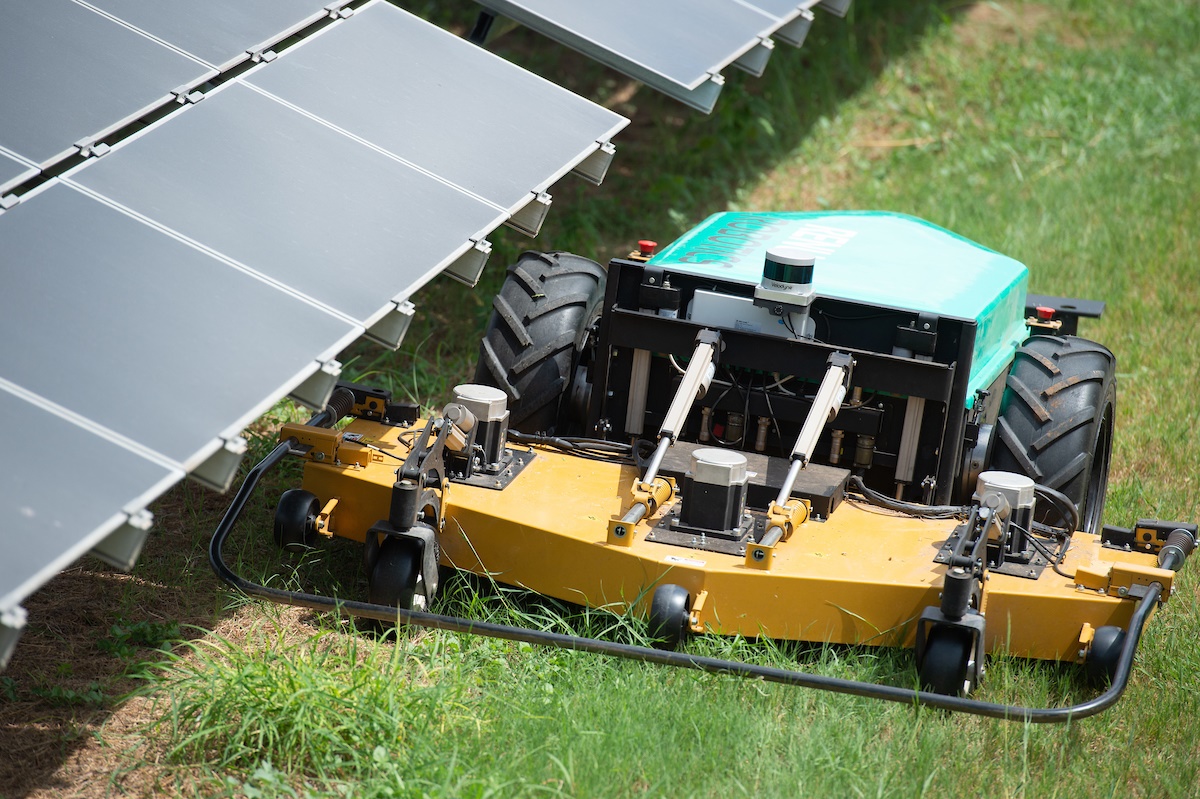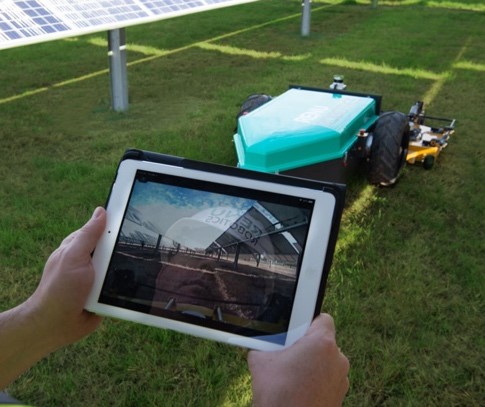 Leveraging AI, wireless communications, sensors, GPS navigation, and centralized management, San Antonio-based Renu Robotics is revolutionizing the way solar energy facilities perform vegetation management. Using a sophisticated, autonomous, electric mowing robot, the company helps utility-scale solar power plants control weeds, grasses, and other vegetation from growing and obscuring solar panels. The results: lower costs and greater safety.
Leveraging AI, wireless communications, sensors, GPS navigation, and centralized management, San Antonio-based Renu Robotics is revolutionizing the way solar energy facilities perform vegetation management. Using a sophisticated, autonomous, electric mowing robot, the company helps utility-scale solar power plants control weeds, grasses, and other vegetation from growing and obscuring solar panels. The results: lower costs and greater safety.
The Challenge of Vegetation Management

At utility-scale solar energy facilities that can span hundreds of acres, there are countless issues that must be managed in order to reduce the cost and improve operations and maintenance of photovoltaic systems and energy storage systems, ensure peak performance, and maximize generation of carbon-free electricity. They can range from environmental, health, and safety regulations to secure data management, personnel training, maintenance and parts inventory. But there’s one simple but vexing problem that can sidetrack even the best solar power facility: runaway vegetation.
That’s because, even on bright, sunny days, photovoltaic solar panels can’t generate environmentally friendly electricity if they’re obscured by grasses, weeds, and other wild vegetation that — if left unchecked — can grow to unmanageable heights. According to Michael Blanton, chief technical officer of Renu Robotics, chemical herbicides and weed killers aren’t the answer. “While these herbicides kill the unwanted plants, they wipe out the plant roots,” he explained. “That leads to soil erosion and destabilizes the solar-panel mountings — to say nothing of their environmental impact and potential hazards to workers.”
That’s led many solar power operators to deploy landscaping crews on a weekly or monthly basis to improve vegetation management and mow down the unwanted growth, leading to high costs and unwelcome safety concerns. “A solar facility could have dozens of people out each day simply mowing down overgrown nuisance vegetation and weeds to ensure solar panels have unobstructed access to sunshine,” said Blanton. “But that means very high costs and substantial risks to site infrastructure and those personnel.”
A Smart, Autonomous Solution for Vegetation Management
 The opportunity to help solar power operators control runaway plants, grasses, and weeds — and reduce costs and safety concerns — led Renu Robotics to create the Renubot. In concert with its Recharge Pod and Mission Control Center, this autonomous, all-electric mower/tractor uses artificial intelligence, Velodyne lidar sensors, real-time kinematic GPS positioning navigation, powerful batteries, wireless communications, and remote management to perform regular and precise mowing between rows of photovoltaic sensors and keep vegetation at acceptable lengths.
The opportunity to help solar power operators control runaway plants, grasses, and weeds — and reduce costs and safety concerns — led Renu Robotics to create the Renubot. In concert with its Recharge Pod and Mission Control Center, this autonomous, all-electric mower/tractor uses artificial intelligence, Velodyne lidar sensors, real-time kinematic GPS positioning navigation, powerful batteries, wireless communications, and remote management to perform regular and precise mowing between rows of photovoltaic sensors and keep vegetation at acceptable lengths.
One of the keys to the Renubot solution: integrated wireless communications from the Digi XBee® PRO 900HP, an embedded module that provides best-in-class wireless connectivity to devices. The XBee PRO 900HP takes full advantage of the DigiMesh® networking protocol, featuring dense network operation and support for sleeping routers. Supporting RF line-of-sight ranges up to 28 miles (with high-gain antennas), and data rates of up to 200 Kbps, these modules are ideal for extended-range applications requiring increased data throughput.
The Digi XBee 900HP PRO is deployed in a mesh network across the acres of solar panels to relay navigational correctional data from a base station to a fleet of Renubot mowers. When those mowers return to their charging pods, they also receive updated scheduling information and routes.
“The Digi XBee 900HP PRO has been an excellent solution for the communications component of our solution,” said Blanton. “We are especially happy with its mesh-networking capability, easy integration, and the range of frequencies supported. Since our implementations can span hundreds of acres, we wanted a choice of radio frequencies to support longer distances.”
According to Jason Beans, senior electrical engineer, Renu Robotics’ integration took place in two phases. “Initially, we used the XBee radio in Transparent mode to emulate a serial cable connection between our base station and the robot mowers,” he said. “This configuration was easy to deploy with very little development effort, and it enabled us to operate our system quickly. Next, we leveraged the API mode and mesh networking to develop the embedded software to operate the XBee nodes in the system.”
Saving Money — and the Planet
 In addition to the Digi modem connectivity, the Renubot solution for vegetation management leverages artificial intelligence for autonomous command and control, while machine learning controls energy usage optimization, self-diagnostics, and sensors/algorithms to learn and assess topography. Navigation is based on a stored map of paths, while sensors detect unexpected objects in that path. With more than 2 million lines of software code and using the industry-leading Robotic Operating System, the Renubot intelligently monitors and controls mowers and wirelessly feeds information about performance, location, and maintenance to operators via laptops, tablets or smartphones.
In addition to the Digi modem connectivity, the Renubot solution for vegetation management leverages artificial intelligence for autonomous command and control, while machine learning controls energy usage optimization, self-diagnostics, and sensors/algorithms to learn and assess topography. Navigation is based on a stored map of paths, while sensors detect unexpected objects in that path. With more than 2 million lines of software code and using the industry-leading Robotic Operating System, the Renubot intelligently monitors and controls mowers and wirelessly feeds information about performance, location, and maintenance to operators via laptops, tablets or smartphones.
“Renubot systems typically save solar and energy facilities 30-50 percent compared to their current costs,” Blanton explained. “Our autonomous tractors have shown asset owners and solar power providers the valuable contribution they can make in cutting costs, time and carbon emissions, while maintaining the grounds for maximum performance of the facility.
“With our solution, operators no longer have to hire and manage mowing crews. That eliminates accidents and optimizes schedules — including the chance to mow facilities outside of daylight hours,” Blanton said.
“Our aim with the Renubot is to support our clients’ vision of clean, renewable energy by utilizing an entirely electric autonomous vehicle. Estimates show that mowing a typical 100 kilowatt site creates 160,000 pounds of CO2 per year. But with Renubot, we’re helping make solar power cleaner and more affordable, which strengthens the future of the solar industry.”